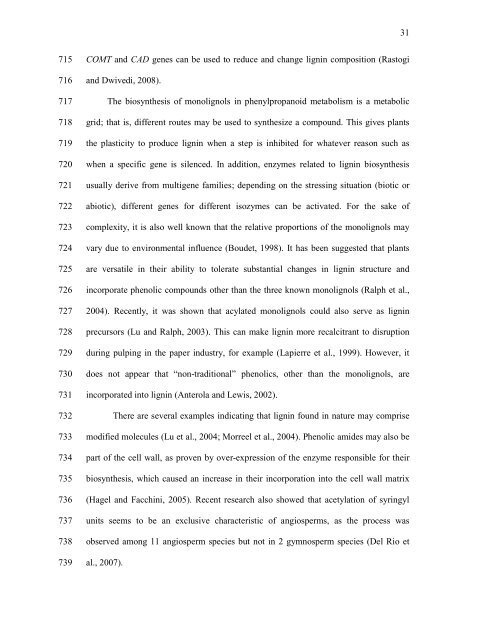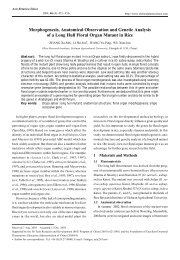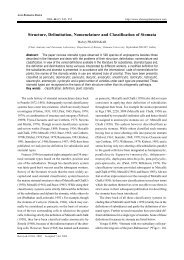Abiotic and biotic stresses and changes in the lignin ... - ResearchGate
Abiotic and biotic stresses and changes in the lignin ... - ResearchGate
Abiotic and biotic stresses and changes in the lignin ... - ResearchGate
You also want an ePaper? Increase the reach of your titles
YUMPU automatically turns print PDFs into web optimized ePapers that Google loves.
31<br />
715<br />
716<br />
717<br />
718<br />
719<br />
720<br />
721<br />
722<br />
723<br />
724<br />
725<br />
726<br />
727<br />
728<br />
729<br />
730<br />
731<br />
732<br />
733<br />
734<br />
735<br />
736<br />
737<br />
738<br />
739<br />
COMT <strong>and</strong> CAD genes can be used to reduce <strong>and</strong> change lign<strong>in</strong> composition (Rastogi<br />
<strong>and</strong> Dwivedi, 2008).<br />
The biosyn<strong>the</strong>sis of monolignols <strong>in</strong> phenylpropanoid metabolism is a metabolic<br />
grid; that is, different routes may be used to syn<strong>the</strong>size a compound. This gives plants<br />
<strong>the</strong> plasticity to produce lign<strong>in</strong> when a step is <strong>in</strong>hibited for whatever reason such as<br />
when a specific gene is silenced. In addition, enzymes related to lign<strong>in</strong> biosyn<strong>the</strong>sis<br />
usually derive from multigene families; depend<strong>in</strong>g on <strong>the</strong> stress<strong>in</strong>g situation (<strong>biotic</strong> or<br />
a<strong>biotic</strong>), different genes for different isozymes can be activated. For <strong>the</strong> sake of<br />
complexity, it is also well known that <strong>the</strong> relative proportions of <strong>the</strong> monolignols may<br />
vary due to environmental <strong>in</strong>fluence (Boudet, 1998). It has been suggested that plants<br />
are versatile <strong>in</strong> <strong>the</strong>ir ability to tolerate substantial <strong>changes</strong> <strong>in</strong> lign<strong>in</strong> structure <strong>and</strong><br />
<strong>in</strong>corporate phenolic compounds o<strong>the</strong>r than <strong>the</strong> three known monolignols (Ralph et al.,<br />
2004). Recently, it was shown that acylated monolignols could also serve as lign<strong>in</strong><br />
precursors (Lu <strong>and</strong> Ralph, 2003). This can make lign<strong>in</strong> more recalcitrant to disruption<br />
dur<strong>in</strong>g pulp<strong>in</strong>g <strong>in</strong> <strong>the</strong> paper <strong>in</strong>dustry, for example (Lapierre et al., 1999). However, it<br />
does not appear that “non-traditional” phenolics, o<strong>the</strong>r than <strong>the</strong> monolignols, are<br />
<strong>in</strong>corporated <strong>in</strong>to lign<strong>in</strong> (Anterola <strong>and</strong> Lewis, 2002).<br />
There are several examples <strong>in</strong>dicat<strong>in</strong>g that lign<strong>in</strong> found <strong>in</strong> nature may comprise<br />
modified molecules (Lu et al., 2004; Morreel et al., 2004). Phenolic amides may also be<br />
part of <strong>the</strong> cell wall, as proven by over-expression of <strong>the</strong> enzyme responsible for <strong>the</strong>ir<br />
biosyn<strong>the</strong>sis, which caused an <strong>in</strong>crease <strong>in</strong> <strong>the</strong>ir <strong>in</strong>corporation <strong>in</strong>to <strong>the</strong> cell wall matrix<br />
(Hagel <strong>and</strong> Facch<strong>in</strong>i, 2005). Recent research also showed that acetylation of syr<strong>in</strong>gyl<br />
units seems to be an exclusive characteristic of angiosperms, as <strong>the</strong> process was<br />
observed among 11 angiosperm species but not <strong>in</strong> 2 gymnosperm species (Del Rio et<br />
al., 2007).







